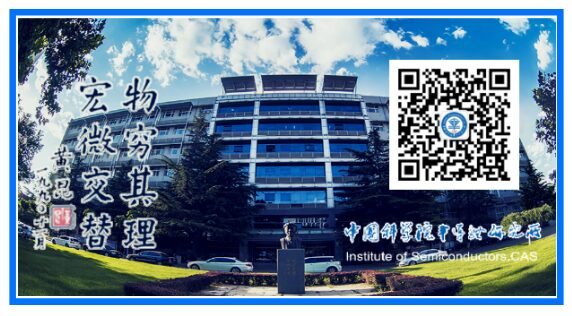
This article is from: Wazi
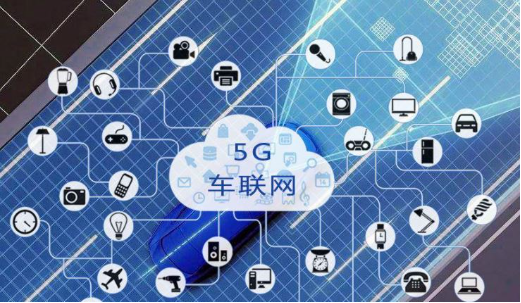
5G inspires limitless imagination, while the Internet of Vehicles inspires limitless aspirations. What exactly is the Internet of Vehicles? You will know after reading this.
Introduction
5G, with its advanced technology (which is not as complex as it seems), can meet the basic and VIP needs of people’s lives and industries. Therefore, the equally high-end and sophisticated Internet of Vehicles will inevitably integrate with 5G.
This also follows a logical principle: true strong entities always attract each other. Because new technologies can only realize their maximum value when they find new applications.
The era of simply constructing and operating networks, where profits came easily from mere connections, is long gone. Consequently, industries closely related to network communication are exploring the application battlefield of new 5G technologies, to fully unleash the high performance of 5G.
Similarly, industrial interconnection is an inevitable scenario for 5G to showcase its capabilities. As the “leading stock” of consumer industries, the automotive industry will undoubtedly be one of the important battlegrounds for 5G.
People envision transforming traffic into a smart car + intelligent road model through the hybridization of vehicles and networks, to achieve safe + efficient transportation. Whether this idea was inspired by Mr. Yuan Longping is now unprovable. However, car + network will hybridize to produce world-changing outcomes, just like high-yield hybrid rice.
Chasing the Dream of Vehicle Networking
In China, the Internet of Vehicles is a new concept that has only recently entered people’s vision. It emerged when the 4G network was relatively well-established, so its history is not long, just a few years. However, in Europe and America, the Internet of Vehicles has been around for over 20 years.
So what exactly is the Internet of Vehicles? What will happen when vehicles hybridize with wireless networks?

When talking about wireless vehicle networking, we must mention another big player in the wireless domain – Wi-Fi. The Wi-Fi standard originated in the West and is widely used worldwide. Although Wi-Fi has issues like security and signal instability, it is still quite good as proven by its widespread application.
Therefore, the research on the Internet of Vehicles abroad has been designed based on a two-layer architecture also based on Wi-Fi.
In other words, the processes of data processing, sending, and receiving signals at the physical layer are similar to those of Wi-Fi (OFDM + MIMO). The network resource allocation and invocation between different vehicles are also variants of the Wi-Fi mechanism (CSMA/CA: hidden node problem, listen before talk, random backoff on conflict, retransmission), and the logical framework is also fundamentally inspired by Wi-Fi design.

However, it was given a new name called DSRC (Dedicated Short Range Communications), used for the technical solutions of vehicle-to-vehicle networking. Using English here is not to show off; just know that vehicle networking uses a Wi-Fi-like network.
Rather than complicating simple matters to appear sophisticated, I prefer to simplify complex issues, even if it seems a bit crude.
However, after so many years of effort, foreign vehicle networking technology has not made significant progress, and amusing incidents still pop up:
-
Vehicles connected via DSRC detected pedestrians and directly crashed into them.
-
A vehicle detected a brick on the road and just stopped dead in its tracks.
And so on, these amusing vehicle networking incidents.
Behind the laughter lies a situation similar to an emperor choosing a successor who is unworthy of the position. At this point, the vast and resource-rich China has established a nearly flawless 4G network.
The current background is a lack of effective network support versus a mature network, a dry twig + a raging fire, very combustible.
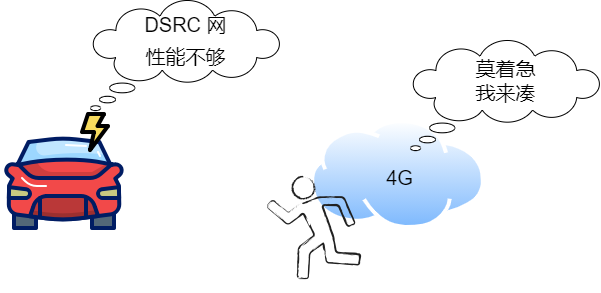
Smart people thought, can we use the 4G network to replace the unreliable DSRC? Thus, we have the Chinese characteristic C-V2X (Cellular Vehicle-to-Everything), which appears complex but is actually not.
The basic logic is simple: just replace the mobile phone with a car and connect to the 4G network. After this, the Internet of Vehicles basically synchronized with the development pace of wireless mobile communication, C-V2X continuously demonstrates its advantages and evolves.
Vehicle Networking Scenarios
Compared to 4G, the performance of 2G and 3G networks is weaker and cannot meet the demands of industrial interconnection, let alone the higher network performance requirements of vehicle traffic systems. Only with the widespread maturity of 4G networks did people begin to envision the Internet of Vehicles relying on 4G.
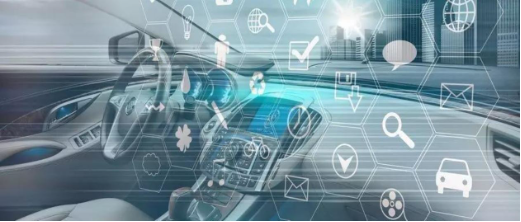
As shown in the image, functions like network search, email, audio-visual, payment, WeChat, and security are all on the agenda.
When the vehicle finds the 4G network, and the 4G network meets the vehicle, many sparks fly. People rely on clothing, horses rely on saddles, and so does this; when the vehicle network combines, it instantly transforms from a simple transportation tool into a high-profile entity.
From a functional classification perspective, network-related, security-related, traffic information-related, communication-related, entertainment-related, navigation-related… all are covered.
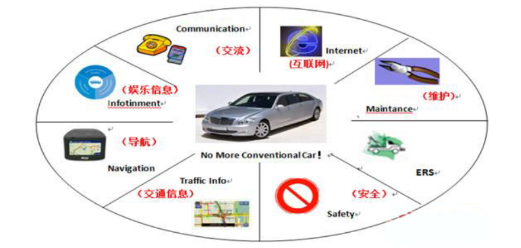
The dream of the past was: upstairs and downstairs, lights and telephones; today’s dream is: inside and outside the car, navigation and broadband.
The past mobile phone was used for making calls, while now making calls has become a secondary need of the phone. Similarly, today’s vehicle is used as a means of transportation, while future travel will become a small attribute of the vehicle, and the vehicle will become more of a mobile living space.

In our country, long-distance buses dominate logistics, so multifunctional vehicle networking is gradually moving towards long-distance vehicles, with the goal still being safe + efficient.
When long-distance freight trucks are networked, the scene looks like this: the lead vehicle acts as the captain, and the speed of the truck convoy relies entirely on the lead vehicle. The lead vehicle transmits real-time road conditions and speed to the following vehicles via wireless signals, and the following vehicles adjust their speed promptly based on the received information, just following the lead vehicle.
Some may wonder, what if there is an emergency situation ahead, and the lead vehicle brakes suddenly? Wouldn’t that cause a chain collision?
Don’t worry, it won’t happen, why? Because signals travel at nearly 8 times the speed of light per second, while the speed of freight vehicles is only about 160 km/h (46.2 m/s), which is negligible in comparison.

In contrast, a vehicle speed of 150 km/h is insignificant, so as long as the communication network is functioning, the lead vehicle can report information to the following vehicles in real-time. In human visual perception, the sudden braking of the following vehicle and the lead vehicle appears to be synchronous, with no time difference at all. Therefore, there is no need to worry about chain collisions.
The networking of freight truck convoys can significantly enhance safety and improve efficiency. Logistics costs in our country account for a significant portion of the national GDP each year. Once freight trucks are networked, after the lead vehicle sets a speed, the following vehicles will generally follow at a constant speed, which can greatly save fuel costs; why not?
It is important to emphasize: in this scenario, lower latency and higher reliability of 5G are required to achieve convoy networking. In urban traffic scenarios, each vehicle acts as a small signal transmitter, continuously broadcasting signals, constantly warning other vehicles:
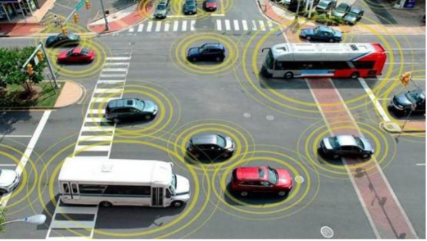
-
Don’t come near me, don’t come near me.
-
Be careful, red light ahead, congestion ahead.
And so on, which can greatly enhance the safety of urban traffic.
Zooming out, the scenario looks like this:
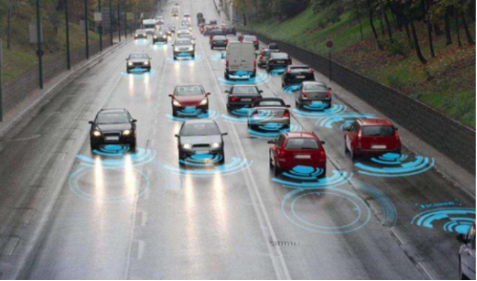
Every vehicle on the road has signal sensing and detection capabilities, notifying surrounding vehicles in real-time about overtaking, lane changes, and sudden braking. In the future, traffic accidents will become rare events, like black swans, and traffic police may face job insecurity.
Next, as depicted, when pedestrians encounter vehicles, it is akin to hitting a stone with an egg, thus this scenario is also a key focus of the Internet of Vehicles.
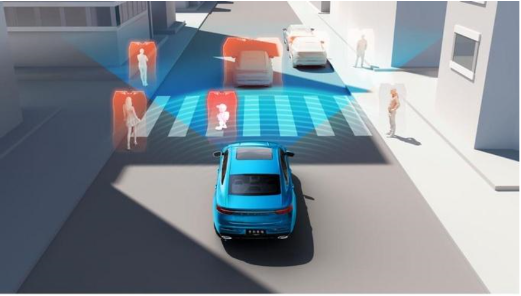
When vehicles possess networking and data processing capabilities, they will constantly detect external situations and analyze and judge the environment. Especially at intersections, they will conduct detailed detection and analysis of external circumstances, and only pass through when proven absolutely safe. If a vehicle detects a safety hazard, the driver will not be able to force the vehicle to move forward.
Thus, at pedestrian crossings, vehicles will be prevented from recklessly rushing through, ensuring absolute safety for people, what a wonderful life!
The above image illustrates the concept of green wave traffic. What is green wave traffic? It’s simply vehicles moving through a series of green lights; isn’t that wonderful?
It is simply marvelous; how is it achieved?
A signal management center is established throughout the city, controlling the timing of red and green lights. Vehicle data, speed, road conditions, and other parameters are analyzed by artificial intelligence to provide a recommended speed for vehicles, and connected vehicles drive at this speed, achieving the scenario of arriving at an intersection with a green light.
WOW, city traffic is coordinated like a game of chess, with centralized management, no traffic jams, fewer accidents, fuel-efficient, and highly effective.
This is the power of the Internet of Vehicles; of course, this process, whether it is real-time uploading of vehicle and road condition information or the central processing of data and timely feedback of results, requires a highly efficient network as a foundational support, and 5G is an indispensable element.
However, there is a problem: if green wave traffic is established, is there really any need for so many traffic lights?
The ultimate goal of the Internet of Vehicles is – Autonomous Driving:
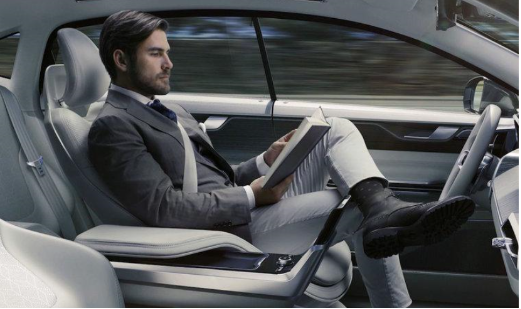
After inputting the destination, the human task ends, and all subsequent operations are analyzed, decided, and chosen by the vehicle, safely and efficiently transporting the owner to the destination, allowing people to be completely liberated to do what they enjoy:
Sleeping, reading, playing cards.
Chatting, drinking tea, playing games.
Political philosophy has broken through from the transportation industry first, moving from an independent kingdom to a free kingdom, this is the ultimate goal of vehicle networking, the end of accidents, and the pioneer of a new era of transportation.
Realization
The previous scenarios are typical intelligent products after the hybridization of vehicles and networks: Hybrid rice yields high output, while vehicle-network hybridization yields high efficiency.
When will it be realized? How will it be achieved? It’s hard to say when, but it shouldn’t be far off.
As for how to achieve it, based on current technical solutions, it is quite simple. Vehicles need to connect with 4G and 5G networks, right? Then they must have the ability to communicate with base stations, and if vehicles communicate with base stations, they become similar to mobile phones, at least they should comply with the communication protocols and data receiving and sending interfaces with base stations.
Rules + Interfaces, it’s that simple.
In this context, 4G and 5G base stations fully manage the connected vehicles.
-
You should send data on this resource.
-
You should receive data on that resource.
-
You should drive at this speed.
-
You should brake suddenly.
And so on; this process is not about communication between the base station and humans, but direct communication between the base station and the vehicle, the vehicle just needs to follow the base station’s commands.
Currently, vehicle networking based on 4G networks manages connected vehicles by broadcasting information, whether from roadside signal emitting devices, 4G base stations, or the connected vehicles themselves, they only broadcast information without caring whether it was received or requiring feedback, which is akin to semi-deaf communication:
Deaf: Reflected in not receiving and analyzing the feedback of the sent information.
Semi: Connected vehicles have the ability to send information and receive broadcast information from other vehicles.
Another method of sending and receiving data is direct communication between vehicles or between vehicles and external people, objects, and devices, without a base station mediating, but rather a direct dialogue between the sending and receiving ends. For example, in the image, the vehicle communicates with pedestrians at the crosswalk, this communication method can save time because the distance between the base station and the vehicle is generally far, but in this communication method, no one tells the vehicle where to send data and where to receive data; it has to guess on its own.
In summary, if there are no parents at home, the order is often a bit chaotic and even uncontrollable.
For entertainment-type large data interactions in vehicles, this communication method can save a lot of resources and bandwidth, because data is directly transmitted to the target vehicle without going through the base station.
There are pros and cons to both methods; using both together is the ideal solution. The entire system is illustrated in the image:
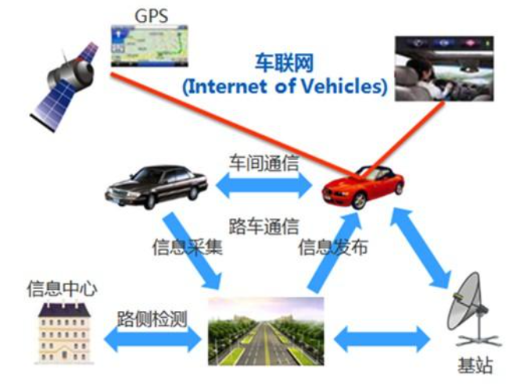
Hey, what about satellites? The role of satellites is merely: positioning and timing synchronization.
A simple example: in green wave traffic, the scheduling center must know the precise location of vehicles to analyze and make decisions accurately. Vehicles must also have an accurate understanding of their location, especially for reminders during overtaking and lane changes on highways, and for unmanned ETC payments, these are all linked through the integration of sensing and positioning, and the accuracy requirement for positioning is very high (sub-meter level). Therefore, high-precision positioning capability will also be an important technical guarantee in the Internet of Vehicles.
Thus, it appears that the Internet of Vehicles will be a systematic project involving automation, electronics, vehicle manufacturing, precision equipment, communication, positioning, and synchronization. Only with coordinated efforts across related industries can the industry better land and bring the Internet of Vehicles into people’s lives sooner.
Conclusion
The Internet of Vehicles is simple: it is the hybridization of vehicles and networks, the reason is also simple: for traffic safety and efficiency; the solution is straightforward, mainly utilizing 4G, 5G networks and direct connection interfaces; the goal is also simple: smart vehicles and intelligent roads.
However, linking and operating the entire system will present points that require in-depth research. Every link is crucial because traffic differs from other industries; a slight mistake can have severe consequences.
Therefore, research on the Internet of Vehicles is a long and heavy task. However, the Pandora’s box of 5G has already been opened, and the ghost has already floated into the realm of the Internet of Vehicles, deeply penetrating, the road is long and winding, but strong demand + reliable technology will surely yield refreshing results.
Editor: Lu Dingci
